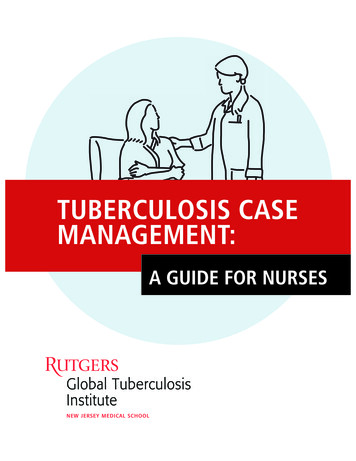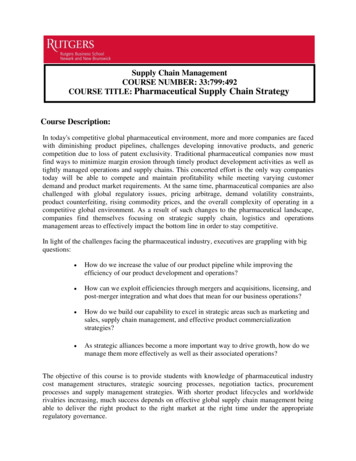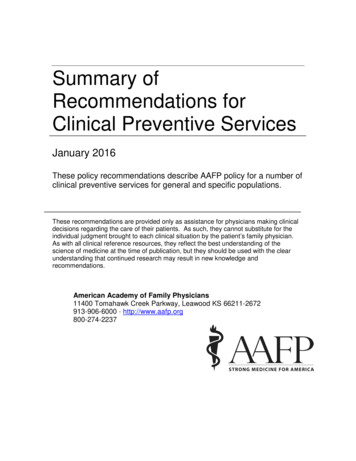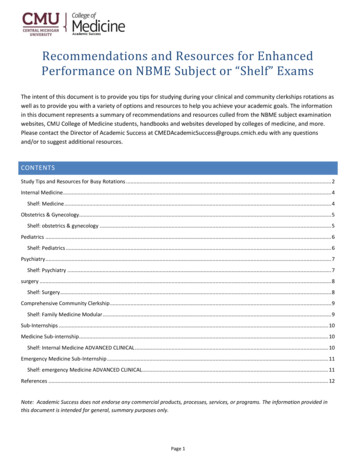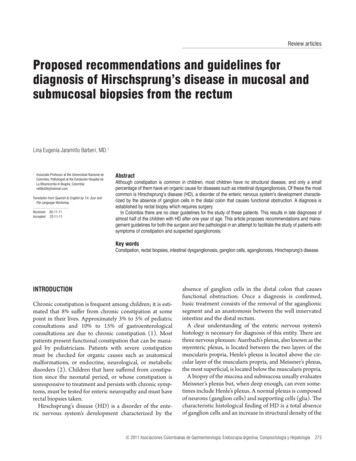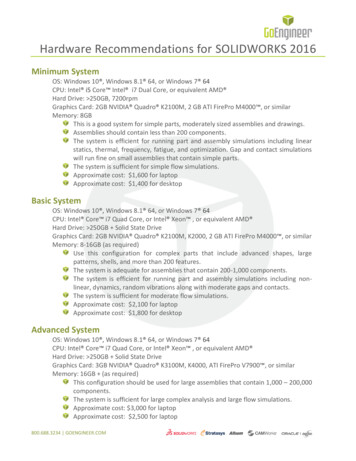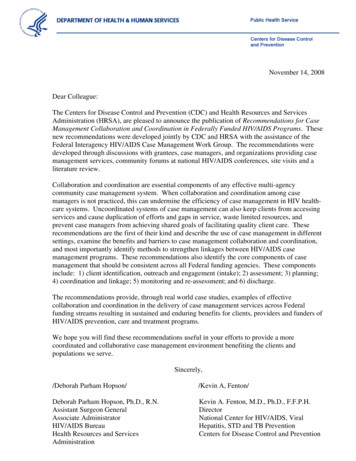
Transcription
November 14, 2008Dear Colleague:The Centers for Disease Control and Prevention (CDC) and Health Resources and ServicesAdministration (HRSA), are pleased to announce the publication of Recommendations for CaseManagement Collaboration and Coordination in Federally Funded HIV/AIDS Programs. Thesenew recommendations were developed jointly by CDC and HRSA with the assistance of theFederal Interagency HIV/AIDS Case Management Work Group. The recommendations weredeveloped through discussions with grantees, case managers, and organizations providing casemanagement services, community forums at national HIV/AIDS conferences, site visits and aliterature review.Collaboration and coordination are essential components of any effective multi-agencycommunity case management system. When collaboration and coordination among casemanagers is not practiced, this can undermine the efficiency of case management in HIV healthcare systems. Uncoordinated systems of case management can also keep clients from accessingservices and cause duplication of efforts and gaps in service, waste limited resources, andprevent case managers from achieving shared goals of facilitating quality client care. Theserecommendations are the first of their kind and describe the use of case management in differentsettings, examine the benefits and barriers to case management collaboration and coordination,and most importantly identify methods to strengthen linkages between HIV/AIDS casemanagement programs. These recommendations also identify the core components of casemanagement that should be consistent across all Federal funding agencies. These componentsinclude: 1) client identification, outreach and engagement (intake); 2) assessment; 3) planning;4) coordination and linkage; 5) monitoring and re-assessment; and 6) discharge.The recommendations provide, through real world case studies, examples of effectivecollaboration and coordination in the delivery of case management services across Federalfunding streams resulting in sustained and enduring benefits for clients, providers and funders ofHIV/AIDS prevention, care and treatment programs.We hope you will find these recommendations useful in your efforts to provide a morecoordinated and collaborative case management environment benefiting the clients andpopulations we serve.Sincerely,/Deborah Parham Hopson//Kevin A, Fenton/Deborah Parham Hopson, Ph.D., R.N.Assistant Surgeon GeneralAssociate AdministratorHIV/AIDS BureauHealth Resources and ServicesAdministrationKevin A. Fenton, M.D., Ph.D., F.F.P.H.DirectorNational Center for HIV/AIDS, ViralHepatitis, STD and TB PreventionCenters for Disease Control and Prevention
Recommendationsfor Case ManagementCollaboration andCoordination in FederallyFunded HIV/ AIDS ProgramsCasent EnvironmentCase Manager 1ClieManageseCar6COLLABORATION&COORDINATIONCLIS ENFF ELF TIC IENCYSUeragnMa2CLIENTCCa5seCase Manager 4easeragnMaManager3A Coordinated & Collaborative Case ManagementEnvironment for the ClientU.S. DEPARTMENTOF HEALTH AND HUMAN SERVICESPublic Health ServiceCenters for Disease Control and PreventionThe Health Resources and Services AdministrationAugust 2008
ACKNOWLEDGEMENTSThe Federal Interagency HIV/AIDS Case Management Work GroupCo-ChairsJeff Bosshart, MSW, MPHPrevention in Care SpecialistDivision of HIV/AIDS Prevention, National Center forHIV/AIDS, Viral Hepatitis, STD, and TB Prevention(NCHHSTP), Centers for Disease Control andPrevention (CDC), Atlanta, GAMary Vienna, RN, BSN, MHADeputy Division DirectorDivision of Training and Technical Assistance,HIV/AIDS Bureau (HAB), Health Resources andServices Administration (HRSA), Rockville, MDMembersCenters for Disease Control and Prevention (CDC), Division of HIV/AIDS PreventionDonna AlexanderPublic Health AnalystJoseph Prejean, PhDBehavioral ScientistMelissa Thomas-ProctorProject OfficerDavid Purcell, JD, PhDSenior Behavioral ScientistCenters for Medicare and Medicaid Services (CMS)Randy Graydon (retired)HIV/AIDS CoordinatorDeanna RaislHealth Insurance Specialist/RegionVIII HIV/AIDS CoordinatorMichael McDaniel (retired)Regional HIV/AIDS Coordinator,DHHS Region IVJoseph RazesHIV/AIDS Program CoordinatorGail Brown StevensonRegional HIV/AIDS Coordinator,DHHS Region VIIHealth Resources and Services Administration (HRSA), HIV/AIDS Bureau (HAB)Brian Feit , MPAProject OfficerSheila McCarthy, BSN, RNChief, Northeastern Central ServicesBranchJohanna G. MessoreActing Chief, Southern ServicesBranchDepartment of Housing and Urban Development’s Housing Opportunities for Persons with AIDS (HUD/HOPWA)Travis EmeryKenneth RodgersCPD SpecialistDavid VosDirector, Office of HIV/AIDSHousingNational Institutes of Health’s National Institute on Drug Abuse (NIH/NIDA)Jerry Flanzer, Ph.D. (retired)Senior Social ScientistSubstance Abuse and Mental Health Services Administration’s Center for Mental Health Services (SAMHSA)Barbara Silver (retired)Director, HIV/AIDS Education, Evaluation, and Services ProgramsCenter for Mental Health Services (CMHS)National Association of Social Workers (NASW)Evelyn Tomaszewski, MSW, ACSWSenior Policy Associate, Project Director1
StaffLaura Caisley, MPH, RNPublic Health Fellow, Centers forDisease Control and Prevention,Atlanta, GAReviewersJames AlbinoNational Minority AIDS Council,Washington, DCDavid AndressActing Director, HIV/AIDS ProgramCoordinator, Area 4 Disease ControlDivision, Jacksonville, FL 32206William E. Arnold, C.E.O.TII CANN - Title II Community AIDSNational Network, Washington, DCJose B. Ashford, MSW, PhD, LCSWProfessor and Associate DirectorASU School of Social Work and Affiliate,Professor of Criminology and Criminal Justiceand Justice and Social Inquiry, Phoenix, AZDiane Arneth, BSN, MPACommunity Health Action of Staten Island,Staten Island, NYSteven S. Bailey, L.C.S.W.Assistant Director of Health Care Services,Virginia Department of Health, Richmond, VAArturo Valdivia Bendixen, M.S.W.Associate Director, AIDS Foundationof Chicago, Chicago, ILPam Briggs, MSW, QMHPDirector, UIC-College of Medicine at Peoria,Heart of Illinois HIV/AIDS Center, Peoria, ILHolly Buckendahl, LMSWKansas City Free Health Clinic,Kansas City, MORomán BuenrostroDirector of Database Managementand Special Projects , AIDS Foundationof Chicago, Chicago, ILBarbara Boshard, RN, BSN, MSCoordinator of Quality ImprovementDepartment of Internal Medicine,University of Missouri-ColumbiaColumbia, MOKathryn CastroField Services Supervisor, Duval County HealthDepartment, Jacksonville, FlBarbara Cuene, RN MSNClinical Nurse Specialist/Program Coordinator,WI HIV Primary Care Support Network,Children’s Hospital of WI, Milwaukee, WIPriya Jakhmola, MS, MBAPublic Health Analyst, Amer Tech,Centers for Disease Control andPrevention, Atlanta, GARegina ToscaTechnical Writer, Contractor, HealthResources & ServicesAdministration, Rockville, MDJames A. Hall, PhD, LISWDepartment of Pediatrics,University of Iowa, Iowa City, IASusan Thorner, M.A.Training Resources Network, Inc.Beltsville, MDJulia Hidalgo, ScD, MSW, MPHResearch Professor, George WashingtonUniversity School of Public Health andHealth Services, Washington, DCMary Evelyn Torres, MBAManager of Client Services,Philadelphia Department of Public Health, AIDSActivities Coordinating Office, Philadelphia, PAShawn Johnson, MSW, GSWCase Management Coordinator,Louisiana Office of Public HealthNew Orleans, LAJesse Ungard; MA, LCADCBaltimore City Health DepartmentBaltimore, MDJennifer KunkelEIS Team Leader/CQI CoordinatorTotal Health Care, Inc.,Baltimore, MDJulia Lager-Mesulam, LCSWProgram Director, Partnership Project,Portland, ORBarbara L. Marcotte, LSWDirector of Programs, Test PositiveAware Network, Chicago, ILPat McGlone MSWUniversity of Pittsburgh Medical Center,Pittsburgh, PAAllen NishikawaCounty of Sonoma Public HealthDivision, Santa Rosa, CALinda Pate-HallBS, Independent Clinical Supervisor,Clinical Substance Abuse Counselor,Horizons Inc., Milwaukee, WICheryl PottsAIDS Foundation of Chicago,Chicago, ILRichard C. Rapp, M.S.W.Assistant Professor, Wright StateUniversity, Dayton, OH 45435Amber Rossman, LMSWKansas City Free Health Clinic,Kansas City, MODavid A. Rosen, MSW, LCSW, C-ASWCMAssistant Director, Division of AIDS Education,University of Medicine and Dentistry of NewJersey, NJDale Stratford, Ph.DBehavioral Scientist, Centers for DiseaseControl and Prevention, Atlanta, GAShelly M. Ebbert, M.P.H.Illinois Department on Aging,Chicago, ILSheila F. Tarbet, Ph.D.Evaluation Manager, The PerinatalCouncil, Oakland, CAAnn Daehling GardnerHIV CTR and Partner Services Coordinator,Arizona Department of Health Services,Phoenix, AZDavid ThompsonSubstance Abuse and Mental HealthServices Administration, Center forSubstance Abuse TreatmentFikirte Wagaw, MPHChicago Department of Public HealthSTD/HIV/AIDS Div., Chicago, ILSandra J. WhiteExecutive Director, United Deliverance Community Resource Center, Inc.,West Palm Beach, FLTony ZepedaYouth Prevention Program Director,Walden House Inc., Los Angeles, CAContributorsMarinna Banks-Shields, MSW, LICSW, BCDSenior Public Health Analyst/Project Officer, CDR U.S. Public Health Service, HealthResources and Services Administration (HRSA),Rockville, MDFabian Eluma, MD, PhD., MPH,Public Health Advisor/ProjectOfficerSubstance Abuse and Mental HealthServices Administration, Rockville, MDBob HoltkampHIV CARE Program CoordinatorMO Department of Health and Senior ServiceDivision of Community and Public HealthJefferson City, MOBecky L. Hutchings, RN, BSN, MSN(C)HIV Case Management Program Manager,Missouri Department of Health and SeniorServices, Springfield, MOFaye JohnsonAzalea Project Manager,Northeast Florida Healthy Start Coalition, Jacksonville, FLClaudia Richards , MSWBranch Chief, HIV & Behavioral Health IssuesBranchSubstance Abuse and Mental Health ServicesAdministration, Rockville, MDRaul Romaguera, DMD, MPHCaptain, USPHSActing Associate Director for Health Disparities,Division of HIV/AIDS Prevention, Centers forDisease Control and Prevention, Atlanta, GAThe Work Group also wishes to thank the generosity and contributions of all those who have made this document possible throughtheir feedback, questions, presentations, technical support, and much, much more. Particularly, the Work Group wishes to thank: The people who participated in interviews and community forums. The people who attended the Work Group meetings and participated in the presentations. The staff of may case management agencies that provided us with their insights and information about their systemof case management.2
TABLE OF CONTENTSAcknowledgements1Executive SummaryI.5Introduction7II. Background Of Case Management81. What is Case Management?2. Evolution and History of Case Management3. Why case management is important forHIV-infected clients?4. Case Management Functions/Activities5. Different Approaches to Case Management101112III. F ederal funding: Different definitions andrequirements for HIV/AIDS Case Management121. Centers for Disease Control and Prevention (CDC)2. Centers for Medicare and Medicaid Services(CMS)/Medicaid3. U.S. Department of Housing and Urban Development(HUD)/ Housing Opportunities for Persons with AIDS(HOPWA)4. Health Resources and Services Administration(HRSA)/Ryan White HIV/AIDS TreatmentModernization Act5. National Institutes of Health (NIH)/National Instituteon Drug Abuse (NIDA)6. Substance Abuse and Mental Health ServicesAdministration (SAMHSA)IV. Issues, Gaps And Barriers That ImpactOn Collaboration And Coordination AmongHIV/AIDS Case Managers1.2.3.4.Financial Issues in Case ManagementLegal and Ethical Issues Related to Case ManagementCollaboration and coordinationSystem-Level BarriersClient-level effects891313141414151516171718
V. A chieving Collaboration And CoordinationIn Systems Of Case Management1. Coordinated versus uncoordinated systemsof HIV/AIDS case management2. Key Elements of successful collaborationand coordination3. Changing Current Systems and Buildingfor the FutureVI. Making collaboration and coordination work:Tools and RecommendationsVII. Conclusion192223242433Figures & TablesFigure 1: Stages in IntegrationFigure 2: Uncoordinated system of case managementFigure 3: Coordinated system of case management202223Appendices34A. ATTACHMENT: MethodologyB. ATTACHMENT: TermsC. ATTACHMENT: Case Management TimelineAnd Classificationsi. Timelineii. ClassificationD. ATTACHMENT: Federal Agency Fundingfor HIV/AIDS Case ManagementE. ATTACHMENT: AcronymsF. ATTACHMENT: References3436373739404444
EXECUTIVE SUMMARYThis document ‘Recommendations for Case ManagementCollaboration and Coordination in Federally Funded HIV/AIDS Programs’ developed by the Federal Interagency HIV/AIDS Case Management Work Group describes the use ofcase management in different settings, examines the benefits and barriers to case management collaboration and coordination, and identifies methods for strengthening linkagesbetween HIV/AIDS case management programs.Case management is widely used in HIV/AIDS programs tofacilitate access to care, stable housing and support servicesfor clients1 and their families. Since the beginning of the HIVepidemic, it has been the cornerstone of programs that seekto address a wide array of medical, socioeconomic and psychosocial factors that affect the functioning and well being ofHIV-infected clients and their families.Data indicate that many people with the disease experiencefactors—such as homelessness, substance abuse, mental illness, poverty and lack of insurance—that affect their abilityto access and benefit from care. Health care programs rely oncase managers to help link these clients with services, treatment and support, and monitor their receipt of necessary careand services. Studies have documented the effectiveness ofcase management in helping clients reduce unmet needs forsupport services such as housing, income assistance, healthinsurance, and substance abuse treatment.1 Other researchhas demonstrated case management’s effectiveness in helpingclients adhere to HIV/AIDS regimens,2 enter into and remainin primary care3,4 and improving biological outcomes of HIVdisease.2 Case management has also been associated withhigher levels of client satisfaction with care.5 The transitionof HIV/AIDS from a terminal disease to a chronically managed condition has placed greater emphasis on the provisionof case management services that highlight prevention andearly entry into treatment.Despite the potential of case management to increase the efficiency of HIV health care systems by linking clients andtheir families to needed services, the absence of cooperationbetween case managers can undermine these objectives. Uncoordinated systems of case management can inhibit client access to services and cause duplication of efforts, gaps in service, waste limited resources and prevent case managers fromachieving shared goals of facilitating quality client care.There are many reasons for lack of collaboration and coordination across programs that provide case management toHIV-infected clients. Federal funders of case managementprograms maintain separate guidelines, funding cycles andThe term client refers to any individual (and his/her defined supportnetwork), family or group receiving case management services. In someinstances, the client may consist of an individual and his/her caregiver oran individual and his/her substitute decision-maker.15data requirements. Federal rules, regulations, eligibility criteria, policies and procedures may also differ from those ofstate funding agencies, a reality that can further complicateefforts to collaborate or coordinate. Competition for clientsand funding, long distances between agencies, particularly inrural areas, and limited resources also play a role.As a result, structural barriers may be created that make it difficult for case managers to work cooperatively wit each other.In addition, while some federal funders provide grantees withguidelines for the provision of case management services,others provide no guidance at all.Legal and ethical issues can affect the ability of case managersto work together effectively, particularly if case managementagencies operate under different philosophies and mandatesthat seem at odds with each other. For example, a practitioner whose focus is on cost containment and service management may find it difficult to achieve common ground with aperson who focuses exclusively on psychosocial needs. Differing interpretations of medical privacy requirements amongcase managers can affect the level of information sharing onclient cases. In efforts to assure client confidentiality, somecase managers may forego opportunities to safely share important information with other case managers who may be ina position to offer assistance.In addition, there is wide variation — and much debate —with regard to the educational levels, credentials, and experience required of those who practice case management.These differences reflect the complexity, intensity and typeof case management services being provided, however theycan create divergent viewpoints on service priorities andbest approaches.While not insignificant, these challenges can be overcome insystems where there is the will and the leadership to makecollaboration and coordination a priority undertaking. Thisdocument provides examples of communities and systems inwhich collaboration and coordination has helped case managers complement, rather than interfere with, each other’sefforts on behalf of clients and their families.Collaboration and coordination, while distinct processes,share a number of key features. Both employ formalized systems of communication, coordinated service delivery, andclient-centered approaches, albeit to varying degrees. Bothprocesses require information sharing between participants toset the broader context for their work and gain knowledge ofavailable resources, the services being provided and the populations being served.
In practice, coordination and collaboration reflect differentlevels of cooperation among agencies or staff. Coordination,for example, generally involves staff of different agenciesworking together on a case-by-case basis to ensure that clients receive appropriate services6. It can involve front-linecase managers, supervisors and even organizational leaders.Coordination does not change the way agencies operate orthe services they provide, rather, it represents an agreementbetween partners to avoid overlap in each other’s efforts andcooperate to some degree in the delivery of services theyalready provide.Collaboration builds on coordination and includes joint workto develop shared goals. It also requires participants to follow set protocols that support and complement the work ofothers. Unlike coordination, collaboration requires the commitment of agency or system leadership to be effective andproduce the kind of sustained change that is central to its objectives. Collaboration has a greater potential to create seamless,client-centered systems of case management, has a greatercapacity for extending the reach of limited resources andgets participants closer to establishing a foundation for truesystems integration.While collaboration yields greater benefits for agencies, systems, and clients, instances exist where collaboration is notpossible or appropriate. But coordination can be an important strategy for improving interagency communiction andpromoting more efficient delivery of case management services to HIV-infected persons. Coordination can help lay thegroundwork for future collaboration.To examine these challenges and offer possible strategies forchange, the Federal Interagency HIV/AIDS Case Management Work Group was convened in November 2003 underthe joint leadership of the Centers for Disease Control andPrevention (CDC) and Health Resources and Services Administration (HRSA). Work Group members included representatives from: the Substance Abuse and Mental Health ServicesAdministration’s Center for Men
Nov 14, 2008 · management that should be consistent across all Federal funding agencies. These components . The Work Group also wishes to thank the generosity and contributions of all those who have made this document possible through their feedback, questions, presentations, technical support, and much,
